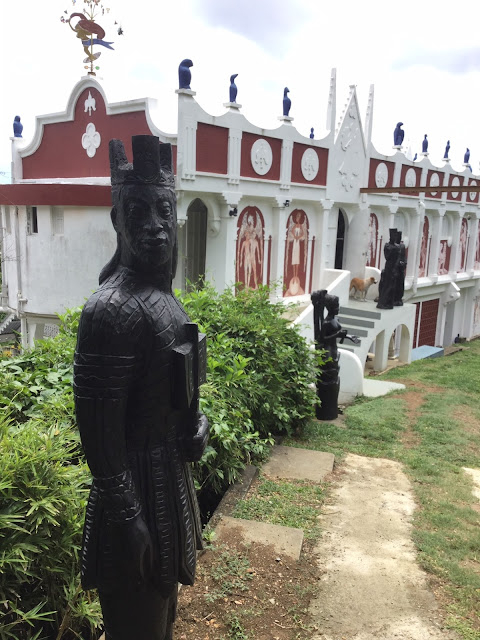Tribute to Tobago Folk
The Tobago Icon Museum (Luise Kimme) in
Bethel is an inspiration for young Tobagonian artists, and a unique attraction
for local and international visitors. It is the home and workshop of the
German-born Luise Kimme, and features artwork from her 30-year love affair with
Tobago. Pat Ganase recommends a visit.
Luise
Kimme came from Germany to the Caribbean in the late 1970s. She had fallen in
love with the distinctive sensuous Tobagonian features, and followed her heart
to Tobago. It was a turning point in her life. She had grown tired of the
contemporary abstract art of Europe, the environment in which she was expected
to work after her studies in prestigious art colleges in Germany and London;
she was at that time a Professor at Dusseldorf Academy (a post which she occupied
until 2002).
Tobago
revitalized her and she turned her back on the trends of the modern art world
to follow a completely new track in sculpting in wood, larger than life figures
of ordinary folk. Through her art, the Tobago folk with their typical poses and
gestures are immortalized in heroic statues and busts and wall pieces. She became
well-known to the village as the woman on the bicycle.
 |
| The god, Shango, in bronze guards the front of Kimme’s Castle |
 |
| Soucouyant, one of Kimme's mythological figures |
Kimme’s
house on the ridge between Mt Irvine and Bethel started as a one-room workshop
in which she worked on massive logs, some local and some imported from Germany.
A tiny woman, she had tremendous strength in her arms to wield the massive
hammer and chisel or chainsaw. She installed the block and tackle pulley system
to raise her logs in place, and would mount a ladder to reach the tops of her
sculpture.
The
house that now stands as Kimme’s Museum grew, as rooms were added around the
workshop. The imposing castle that today houses the museum is decorated with
deities – mainly from the Orisha pantheon – on the outside. Inside, we see
phases of Kimme as the complete artist. She was accomplished in drawing and
painting; and many of her small sketches and artworks are collected in one
room. Her art pieces included needlework when she was not strong enough for the
chisel or chainsaw.
Kimme
loved the fretwork decorating many older houses of the colonial era. However,
once she became adept at the jigsaw, her depictions could not be restricted to
the stylized patterns of architectural fretwork. And she created lovely
free-form panels with graceful human gestures. You can view such a line of
dancers framing a balcony at the museum; study how she evokes the movement and
flair in these flat but sculptural shapes.
Her
iconic pieces, however, are the heroic wood sculptures, always a few feet
taller than ordinary. She crafted calypsonians, mothers and children and
handsome men, in lifelike colourful garb. She loved and accentuated the traits
defining personalities and character: Spiritual Baptist leaders; and especially
dancers. One series presented creatures of Trinidad and Tobago myth:
Soucouyant, Papa Bois and Mama de l’eau.
 |
| Two bronze figures at the entrance of the Luise Kimme Museum |
 |
Blue
boy and a mother earth figure, a pair of wall panels
|
Throughout
her life, Kimme worried about the endurance or perishability of her work in
wood. She was acutely aware of the ravages of the tropics even on hardwoods:
moulds and fungus and invisible boring insects. She was determined to preserve
as many of her sculptures as possible by casting them in bronze. She travelled
to Cuba where she learned mould-making and bronze casting. She met many
artists, one of which, Dunieski Lora Pileta, worked with her. In the museum,
there’s a room of Kimme’s “tiny sculptures” which she made while practising
bronze casting. Dancers and deities are among the figures she portrayed.
She
encouraged Dunieski to return with her to Tobago to set up a kiln and foundry
in order to convert her wooden sculptures to bronze. Luise Kimme died in April
2013 before this process could begin. Since then, her sister Ilse has taken
over Kimme’s estate, allowing it to be preserved as a Tobago museum. Dunieski has
been employed as the curator; and together they are working to complete the
transformation of Kimme’s Tobago folk to bronze.
Luise
Kimme’s journal of her early years in Tobago, 1981-1983, was published in the
book, Chacalaca. It’s another name for the noisy native bird also called
cockrico. This book is full of Kimme’s first impressions of Tobago and
Tobagonians, with many drawings and illustrations. Other books featuring
photographs of her sculptures have also been published. Her work has been shown
in Germany and in Trinidad and Tobago, and in Cuba.
The
Tobago Library Services has arranged for children’s tours of the Kimme Museum.
Otherwise, public visiting hours are 10 am to 2pm on Sundays.
 |
| Luise Kimme, photo by Ranji Ganase |
 | |
| Kimme fell in love with the Tobagonian profile, including what she once called the "sheep's mouth." |



